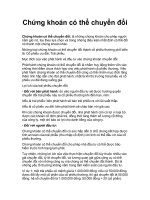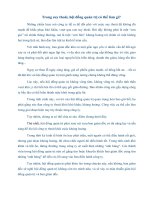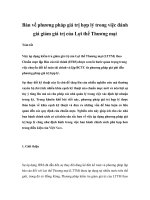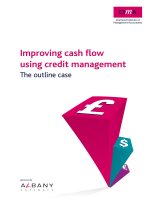Your money what the Bank does ... docx
Bạn đang xem bản rút gọn của tài liệu. Xem và tải ngay bản đầy đủ của tài liệu tại đây (344.73 KB, 11 trang )
£
£
£
£
£
£
£
nfl
spending
d
s
av
i
ng
s
i
n
te
r
est
r
ates
risks
Your money
what the Bank does
The Bank’s
role centres
on money:
your money
You need to know your money will
keep its value. Rising prices – inflation –
reduce what your money is worth.
The Bank sets the official interest
rate – Bank Rate – to keep inflation low.
Interest rates influence how much
money everyone spends and saves and,
in turn, costs and prices.
You need to be confident that
the financial system handles your
money in a reliable way.
The Bank assesses the health of the
financial system as a whole, and
works with others to keep it stable.
You need to be able to trust that
your money is the real thing.
The Bank issues most of the country’s
banknotes which have special
security features to make them hard
to copy.
Low
inflation
Trust in
banknotes
Stable
financial
system
What the Bank does
The Bank of England is the
UK’s central bank. It’s not
like a bank in your local high
street. It has special functions
that help keep the economy
and financial system stable.
That affects us all.
Low inflation, trust in banknotes and a stable financial
system are key ingredients for the economic well-being
of our country.
21
It’s a fact that lots of spending can
push prices up. Inflation is about rising
prices. But it’s not just about prices for
individual products – these rise and
fall all the time. Inflation occurs when
prices are rising for goods and services
generally.
The rate at which prices are rising
reflects the amount of spending in the
economy compared with what can be
produced, and the pressure this demand
puts on company costs and prices.
If the value of spending increases too
quickly, costs and prices tend to rise –
that’s inflation.
The value of your money –
inflation and interest rates
What your money is worth depends
on the prices you pay for things.
Rising prices reduce the value of
money – your money buys less.
£
£
£
£
£
£
£
£
£
£
£
£
£
£
£
£
£
£
£
£
£
£
£
£
£
£
£
£
£
£
£
£
£
£
£
£
£
£
£
£
£
£
£
£
£
£
£
£
£
£
£
£
£
£
£
£
£
£
£
£
£
£
£
£
£
£
£
£
£
£
£
£
£
£
£
£
£
£
£
£
£
£
£
£
£
£
£
£
£
£
£
£
£
£
£
£
£
£
£
£
£
£
£
£
£
£
£
£
43
Inflation in the UK is fairly low today,
but it used to be much higher. In the
1970s, it averaged 13% a year and
reached a peak of 27% in August 1975.
Things got better in the 1980s, but
inflation still averaged 7% a year.
High inflation is bad news for the
economy as costs and prices keep rising.
And bringing inflation under control
can be painful. Interest rates might
have to go up significantly, leading to
weaker economic activity with company
closures and job losses.
It’s also bad news for your money.
Money buys less when prices rise. The
effect of inflation means a shopping
bill of £25 in 1970 has risen to over
£250 today!
13%
27%
7%
2%
It’s the Bank’s job to maintain
the value of money by keeping
the rate of inflation at a low level.
1970s
1975
1980s
2003-2007
CPI
target
65
2%
The Government’s
2% inflation target
The Bank aims to keep the
annual rate of inflation at 2% –
the inflation target set by the
Government. Some prices
will rise by more, others by
less. But, on average, the
aim is that prices across
the economy rise by
2% a year.
Since 2003, the inflation target has been set
in terms of the Consumer Prices Index (CPI).
7 8
Bank Rate
A committee of nine experts – the Monetary
Policy Committee (MPC) – meets each month to
set the official Bank interest rate, known as Bank
Rate. They each have an independent vote to
decide what interest rate to set. There is no
Government influence on the MPC’s interest
rate decisions.
Looking into the future
Interest rates can take up to two years to affect
inflation. So today’s Bank Rate decision is based
on where the MPC thinks inflation is heading
over the next few years. That is always uncertain
because unexpected things will happen.
Bank
Rate
Low inflation helps
businesses and people
plan ahead without
thinking that interest
rates and inflation are
going to be 10% or 15%.
So nobody knows what the interest rate will be
in the future. Each month the MPC looks at how
the economy is faring and whether the outlook
for inflation has changed.
How do interest rates affect inflation?
The interest rate set by the MPC affects interest
rates on mortgages, loans and savings.
Market
interest
rates
spending
loans
savings
Higher interest rates take money
out of the economy by increasing
the amount we pay on our loans
and the interest we receive from
our savings. This influences what
people and companies spend and
save. Less spending puts down-
ward pressure on price increases.
Lower interest rates are used to
increase spending when inflation
looks likely to be below the target.
Low
inflation
109
Did you know?
There are around 2 billion of our
banknotes in circulation, worth about
£38 billion. In 2007 the Bank printed
around 500 million new notes, and
destroyed around 700 million old notes.
There are four denominations of
Bank of England note: £5, £10, £20
and £50. Each has its own design, and
larger value notes are bigger in size.
The most common note in circulation
is the £20 – the rarest is the £50.
Our banknotes, your money
Promises, promises
The Bank of England has been issuing
banknotes for over 300 years. Early
banknotes were receipts for gold
deposited at the Bank. The holder of a
banknote could bring it to the Bank of
England and exchange it for gold.
This is no longer possible, but
banknotes still retain the words
‘I promise to pay the bearer on demand’.
The Bank will always exchange new
banknotes for old ones that it has
withdrawn from circulation.
Value and trust
A banknote is only a piece of paper
which costs a few pence to produce.
But banknotes are worth something
more because we trust they can be
exchanged for things we want to buy –
they are a widely accepted way of
paying for things. This trust gives
banknotes value.
The Bank protects trust in banknotes
by ensuring that they are hard to copy,
so that fake notes don’t undermine
confidence in the real thing.
Counterfeit notes are worthless.
Our banknotes
have a range of security
features. They are made
from a special cotton-based
paper which gives them their
unique feel. They also contain
a range of security features
including raised printing,
metallic threads,
watermarks and
holograms.
R
a
i
s
e
d
P
r
i
n
t
i
n
g
M
e
t
a
l
l
i
c
T
h
r
e
a
d
s
W
a
t
e
r
m
a
r
k
s
H
o
l
o
g
r
a
m
s
The Queen has featured on the front
of Bank of England notes since 1960.
The reverse side has images of eminent
British people. Currently, these are
Elizabeth Fry, Charles Darwin, Adam
Smith and Sir John Houblon.
In Scotland and Northern Ireland, some
commercial banks also issue banknotes.
And it is the Royal Mint, not the Bank,
that issues the nation’s coins.
1211
Your money moves around the
financial system every day –
each time you use a cash point,
pay for something, receive your
wages, put savings in the bank,
invest your money through a
pension fund, or borrow to buy
a home or a car.
Your money and a
stable financial system
The many different parts of the
financial system are all linked
together, because financial institutions
like banks do business with each other.
These links are beneficial. They allow
money to flow around the economy
and channel money from savings into
new investments, which is vital for
the economy.
But these linkages can mean that a
problem in one part of the financial
system can spread to other parts. If a
financial institution gets into difficulty,
this might stop its normal business
dealings with other banks, and could
leave them short of cash or exposed in
some way. Similarly, if systems used
to move money around experience
problems, this could cause wider
problems if payments are not made.
If things go badly wrong, one bank’s
problems might bring others down.
This could put your money at risk.
£
£
£
£
£
£
£
Risks
1413
The Bank and
financial stability
Our reliance on the financial system means
it needs to operate in a safe and reliable way.
One of the Bank’s roles is to provide
extra money to the banking system
in times of difficulty, so a lack of
immediate cash doesn’t cause the
system to stop operating. This isn’t
free money. It is lent to banks to get
more cash into the system, and has
to be paid back.
The Bank of England works
with the Financial Services
Authority – the body that sets
rules and guidelines for financial
institutions – and the Government
to maintain the stability of the
financial system as a whole.
The Bank assesses where
potential weak spots might
lie in the financial system.
We want to reduce the risk
that a problem in one part
has a damaging impact on
the rest of the system.
There will always be risks in the
financial system. It’s not the
Bank’s job to eliminate risk-taking
by individual institutions. The
Bank’s job is to work with others
to help ensure that problems at
one financial institution don’t
disrupt the way the system as
a whole operates.
£
£
£
£
£
£
£
1615
It sets interest
rates to keep
inflation low to
preserve the value
of your money
It issues
banknotes with
special security
features so you
know your money
is the real thing
It assesses
the health of the
financial system
and works with
others to keep
it stable
What the Bank does
More information about the Bank of England
can be found on its website at:
www.bankofengland.co.uk
The Bank has produced educational resources for
primary and secondary schools, explaining money,
prices and the workings of the economy.
You can view the material at:
www.bankofengland.co.uk/education
The Bank provides a range of material to help
identify genuine banknotes at:
www.bankofengland.co.uk/banknotes
Visit the Bank’s free Museum.
Details are available at:
www.bankofengland.co.uk/museum
The Bank
of England
is the UK’s
central bank
17
£
£
If you have any questions or enquiries
about the Bank of England, you can
write to:
Public Information & Enquiries Group
Bank of England
Threadneedle Street
London
EC2R 8AH
or email us at
www.bankofengland.co.uk
You can telephone the Bank’s public
enquiries team on 020 7601 4878
ISBN 1 85730 109 9 (Print and on-line)









